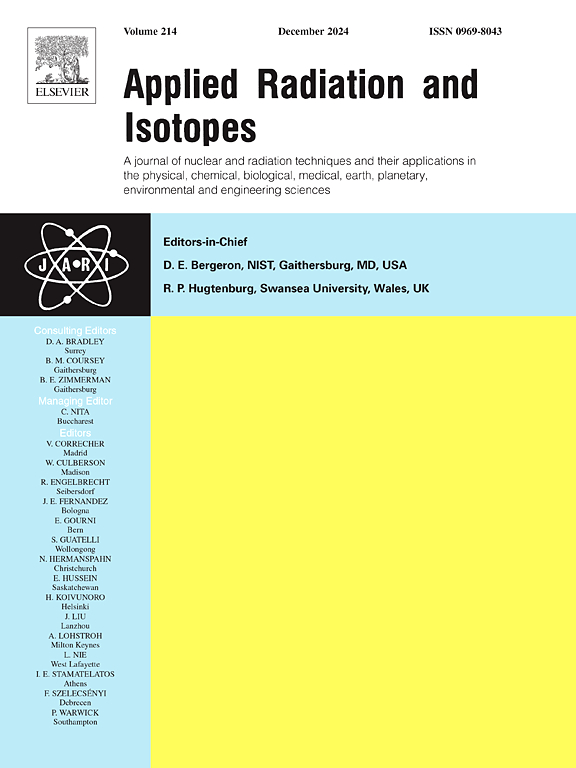Performance study of GaN-based betavoltaic nuclear batteries with 3D interfaces
IF 1.6
3区 工程技术
Q3 CHEMISTRY, INORGANIC & NUCLEAR
引用次数: 0
Abstract
This study presents a design of a 3D interface simulation model featuring an inverted pyramid structure. Our objective is to forecast the performance of GaN-based betavoltaic nuclear batteries with the PN junction 3D interface structures comparing a practical machining process. Initially, we computed the electron-hole pairs (EHPs) generation rate in GaN materials irradiated by both 63Ni and 147Pm sources using Geant4. Furthermore, we employed COMSOL Multiphysics, a finite element analysis software, to simulate the EHPs transport phenomena within the battery and investigate the influence of structural parameters on the output performance. Despite maintaining thicknesses of the P- and N-regions and consistent doping concentrations (Hp-GaN, Hn-GaN, Na, and Nd) as constants, the simulation results revealed notable disparities in the short-circuit current density (Jsc), open-circuit voltage (Voc), and maximum output power density (Pmax) among batteries irradiated with various radioactive sources. Subsequently, we investigated the output performance of the nuclear battery by altering parameters such as the number of inverted pyramid structures, junction depth, and type of radioactive source. Our investigation revealed that selecting 63Ni as the radioactive source, with Na at 1017 cm−3, Nd at 1014 cm−3, a junction depth of 0.1 μm, and inverted pyramid structures of 25, resulted in the following battery performance parameters: a short-circuit current density (Jsc) of 0.648 μA/cm2, an open-circuit voltage (Voc) of 2.3481 V, and a maximum output power density (Pmax) of 1.2949 μW/cm2. Substituting the radioactive source with 147Pm, the average short-circuit current density, Jsc, increased to 56.865 μA/cm2, and the maximum output power density, Pmax, increased to 94.975 μW/cm2, It's a significant enhancement in output performance.
具有三维界面的氮化镓基光伏核电池性能研究
本研究介绍了以倒金字塔结构为特征的三维界面仿真模型的设计。我们的目标是预测采用 PN 结三维界面结构的氮化镓基光伏核电池的性能,并对实际加工工艺进行比较。首先,我们使用 Geant4 计算了氮化镓材料在 63Ni 和 147Pm 源辐照下的电子-空穴对(EHPs)生成率。此外,我们还利用有限元分析软件 COMSOL Multiphysics 模拟了电池内的电子空穴对传输现象,并研究了结构参数对输出性能的影响。尽管保持了 P 区和 N 区的厚度以及一致的掺杂浓度(Hp-GaN、Hn-GaN、Na 和 Nd)作为常数,但模拟结果显示,使用各种放射源辐照的电池在短路电流密度 (Jsc)、开路电压 (Voc) 和最大输出功率密度 (Pmax) 方面存在显著差异。随后,我们通过改变倒金字塔结构数量、结深度和放射源类型等参数,研究了核电池的输出性能。研究结果表明,选择 63Ni 作为放射源,Na 为 1017 cm-3,Nd 为 1014 cm-3,结深为 0.1 μm,倒金字塔结构数为 25,可获得以下电池性能参数:短路电流密度 (Jsc) 为 0.648 μA/cm2,开路电压 (Voc) 为 2.3481 V,最大输出功率密度 (Pmax) 为 1.2949 μW/cm2。用 147Pm 代替放射源后,平均短路电流密度 Jsc 增加到 56.865 μA/cm2,最大输出功率密度 Pmax 增加到 94.975 μW/cm2,输出性能显著提高。
本文章由计算机程序翻译,如有差异,请以英文原文为准。
求助全文
约1分钟内获得全文
求助全文
来源期刊

Applied Radiation and Isotopes
工程技术-核科学技术
CiteScore
3.00
自引率
12.50%
发文量
406
审稿时长
13.5 months
期刊介绍:
Applied Radiation and Isotopes provides a high quality medium for the publication of substantial, original and scientific and technological papers on the development and peaceful application of nuclear, radiation and radionuclide techniques in chemistry, physics, biochemistry, biology, medicine, security, engineering and in the earth, planetary and environmental sciences, all including dosimetry. Nuclear techniques are defined in the broadest sense and both experimental and theoretical papers are welcome. They include the development and use of α- and β-particles, X-rays and γ-rays, neutrons and other nuclear particles and radiations from all sources, including radionuclides, synchrotron sources, cyclotrons and reactors and from the natural environment.
The journal aims to publish papers with significance to an international audience, containing substantial novelty and scientific impact. The Editors reserve the rights to reject, with or without external review, papers that do not meet these criteria.
Papers dealing with radiation processing, i.e., where radiation is used to bring about a biological, chemical or physical change in a material, should be directed to our sister journal Radiation Physics and Chemistry.
 求助内容:
求助内容: 应助结果提醒方式:
应助结果提醒方式:


